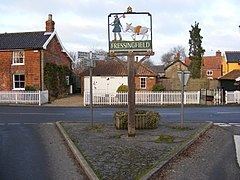Population 1,021 (2011) Sovereign state United Kingdom Local time Friday 3:30 PM | OS grid reference TM247776 Post town EYE Dialling code 01379 | |
 | ||
Weather 9°C, Wind W at 32 km/h, 64% Humidity UK parliament constituency Central Suffolk and North Ipswich | ||
Fressingfield church
Fressingfield is a village in Suffolk, England, 12 miles (19 km) east of Diss, Norfolk. It has a population of over 900, with two shops, a medical centre, public house, restaurant, primary school, and three churches, with Anglican, Baptist and Methodist congregations. A vineyard, Oak Hill Wines, is also located nearby.
Contents
Map of Fressingfield, UK
The parish of Fressingfield contains 4,618 acres (18.69 km2). Of the more than 500 parishes in Suffolk, Fressingfield is the 16th largest.
History
A Roman Road 15 miles (24 km) long, from Pulham St Mary to Peasenhall, passes through the parish of Fressingfield. Its route is recognisable as the present B1116 passing through Weybread ("Weybread Straight"). At the present-day Gooch's Farm, however, an early medieval diversion takes traffic into Fressingfield.
Fessefelda [sic] as it was spelt, or perhaps misspelt, at the time, was first documented in the Domesday Book (1086). Later variants of the spelling have included Frisingfeld (1185), and Freshingfield (17th century).
Fressingfield is an Old English name. It appears to have been initially *Frisa/Fyrs/Fyrsen + inga ("people) + feld ("field"). The original meaning of the prefix is unclear and there are two theories about it:
The Church of St Peter & St Paul was constructed from the early 14th to late 15th centuries. The belfry hangs a ring of eight bells with the tenor weighing 17-0-20 cwt (872.67 kg).
In the late 16th century, the Norwich-born playwright Robert Greene named a character, "Margaret, the Fair Maid of Fressingfield" in his play Friar Bacon and Friar Bungay.
A Guildhall was built the Elizabethan era. (Still standing, it serves as a restaurant.)
The peak population of 1,491 people was recorded by the 1851 Census.
In 1887, to celebrate Queen Victoria's Golden Jubilee, a well was sunk at the junction of the Stradbroke and Laxfield Roads. For 60 years, until the provision of a mains water supply, the "Jubilee Pump" and the "Low Pump" (which still exists) supplied the central area of the parish with water. The site of the Jubilee Pump is now known as Jubilee Corner.
The 1953 Coronation Celebrations Committee chose Jubilee Corner as the site a village sign, depicting a pilgrim and his pack mule. The sign reflects the parish's association with the pilgrimage to Bury St Edmunds that commenced during the late Anglo-Saxon period. In 2002, to mark Queen Elizabeth's Golden Jubilee, a new sign was commissioned, the old one having been given to the school.
While Fressingfield once had five public houses it now has only one, the Swan Inn.
Facilities
There is a playing field in Fressingfield which is used by Fressingfield FC for training and home matches on Sundays. Because of this there are two permanent goals and many other non-fixed goalposts. Alongside the football pitch there are tennis courts and a bowling green.
Fressingfield also has a park with two slides, a swing set, a wooden climbing frame and multiple benches.
Bottle banks are located next to the playing field.
